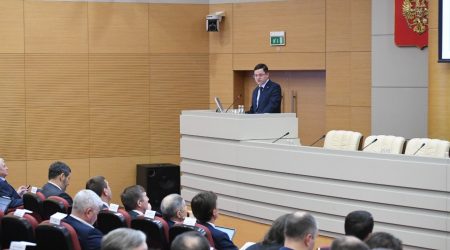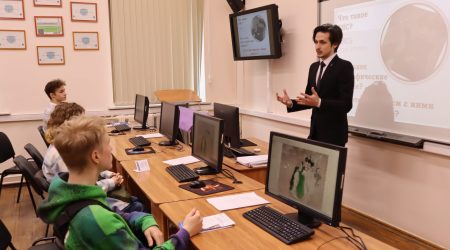Center for Liquid Hydrocarbons’ five-year results discussed in Moscow
Vice-Rector for Earth Sciences Danis Nurgaliev spoke in front of a panel of experts of the Coordination Center of the Government of Russia.
The event was joined by the Minister of Science and Higher Education of Russia Valery Falkov and chaired chaired by Deputy Prime Minister Dmitry Chernyshenko.
Also present were Vice President of the Russian Academy of Sciences Stepan Kalmykov, representatives of the Ministry of Labor and Social Protection, the Ministry of Agriculture, the Ministry of Industry and Trade, the Ministry of Digital Development, Communications and Mass Media, the Ministry of Energy, the Federal Agency for Subsoil Use, and others.
The new stage of development of the centers will be implemented within the framework of the state program Scientific and Technological Development of the Russian Federation, the Deputy Prime Minister said at the meeting.
He reminded that last year President Vladimir Putin clarified the strategic goal-setting in science and in this regard said that it is especially important to concentrate efforts on the tasks set by the head of state. In accordance with current challenges, the country’s strategic priorities in science and technology have been updated.
“This year’s competition will be aimed at creating centers of the same format as the existing ones, but with a focus on the development and implementation of the most important science-intensive technologies up to and including the sixth level of technological readiness. The Ministry of Education and Science has carried out work to take into account the areas of humanities and social sciences,” the Deputy Prime Minister informed.
Minister Falkov focused on attracting young employees to world-class scientific centers. According to him, the centers create opportunities for researchers to manage scientific projects, thereby motivating talented young people to engage in science and increasing the prestige of the scientific profession.
Then, representatives of world-class scientific centers spoke about their developments that have practical significance.
“The Center for Liquid Hydrocarbons was created on the basis of four leading universities in the country engaged in research and development in oil and gas,” started Danis Nurgaliev.
Speaking about the results, the vice-rector emphasized that over five years (from 2020 to 2024), a number of environmentally friendly, cost-effective and energy-efficient methods and technologies for the prospecting, exploration and development of oil fields have been created.
“For example, our technology for forecasting and exploring large and giant hydrocarbon deposits on land and on the shelf has found application both in well-explored regions, such as the Volga-Ural basin, and in the new one – Eastern Siberia, where the coverage of geological studies is yet quite patchy. The technology includes unique methods that make it possible to reduce the time and cost of geological exploration by 2-3 times, especially in new territories,” he informed.
The methods and software developed by scientists are successfully used by companies in the late stages of the development of large fields, when the well fluid contains only 3 to 5 percent of oil.
“The use of the created innovations allows us to reduce the water content in the produced fluid, helps to reduce the cost of production, reduce environmental risks and increase the available reserves at the field, extending its life. This is achieved by obtaining and processing large volumes of production data and original types of geochemical information using neural networks and artificial intelligence. The introduction of our technologies at old fields, where the necessary technological and social infrastructure already exists, will allow us to additionally involve at least 20 billion tons of oil in development by increasing its recovery factor,” said the Vice-Rector. Some developments, the speaker added, are already being implemented. For example, new reagents have found application for enhancing oil recovery – organic dispersions of metallic sodium. They not only reduce the viscosity of oil in the reservoir, but also reduce the sulfur content.
Several of the most effective technologies, such as the technology for assessing the oil and gas potential of large territories, according to Professor Nurgaliev, are currently being replicated not only in Russian companies, but are also in demand abroad – in China, countries of the Persian Gulf, Africa, and Central America.
“Along with the increase in the share of unconventional reserves, the demand for catalytic aquathermolysis technology is growing. We have already achieved remarkable results using it in Tatneft, in divisions of Rosneft and Lukoil, in Cuba together with the company Zarubezhneft, where we have increased production at the Boca de Jaruco field more than twofold. We are planning to start working with Venezuela: an agreement was recently signed in Caracas with PDVSA,” the Vice-Rector noted.
The Center has created and successfully tested 20 low-tonnage chemical products to improve the efficiency of oil deposit development. Dr Nurgaliev added that the construction of an engineering center has begun at Kazan University, where these reagents will be produced in volumes sufficient for industrial use in oil and gas companies.






